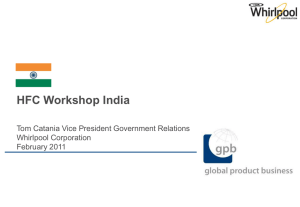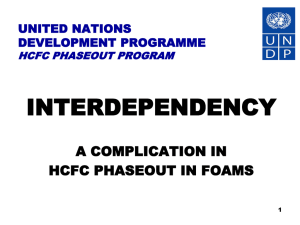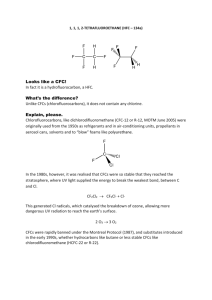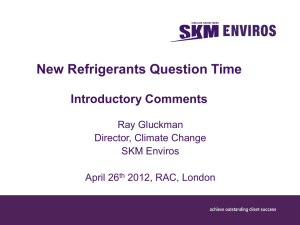Presentation Slides
advertisement
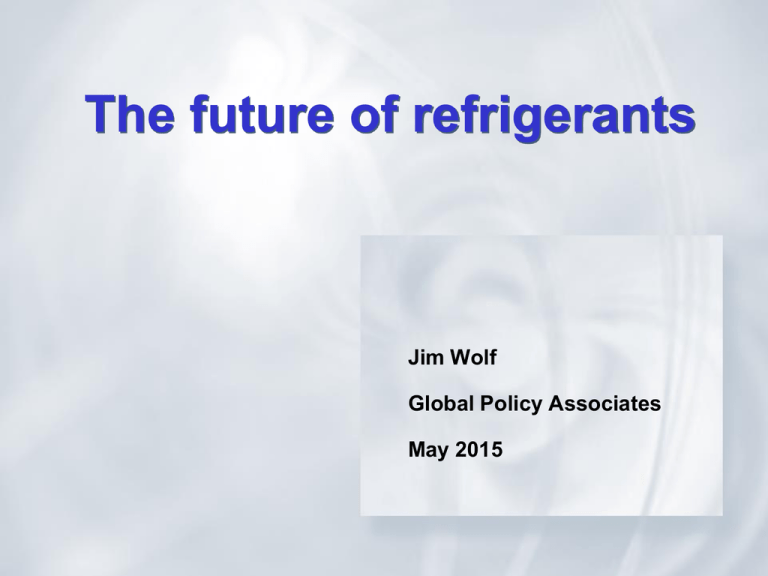
The future of refrigerants Jim Wolf Global Policy Associates May 2015 Overview Current and future environmental policy Refrigerant comparisons Future refrigerants Montreal Protocol Adopted in Montreal on September 16, 1987 Objective “To control and eventually eliminate … OZONE-DEPLETING substances .” Among 6 major chemicals, CFC and HCFC refrigerants were classified as an Ozone Depleting substances, and subject to phase outs. Kyoto Protocol December 1997, Kyoto Japan, Conference of Parties Kyoto Protocol focus is on Global Among 6 major chemicals, HFC Warming. refrigerants were classified as Global Warming, or Greenhouse Gases, and subject to restrictions. Efficiency Drives Environmental Impact Important Environmental Policy Montreal Protocol (UNEP) Kyoto Protocol (UNFCCC) Country Policies and Regulations Montreal Protocol: HCFC Phase out Dates Copenhagen - 1992 Developed Countries, except EU 27 1996 2004 2010 2015 2020 2020 I 2030 Freeze quantities 35% reduction 65% reduction 90% reduction 99.5% reduction remaining 0.5% is for service only Total phase out 2016 Freeze quantities at 2015 levels Developing Countries No interim step down 2040 Total phase out European Union Montreal - September 2007 1996 2004 2010 2015 2020 2020 I 2030 Freeze quantities 35% reduction 75% reduction 90% reduction 99.5% reduction remaining 0.5% is for service only Total phase out 2013 Freeze quantities Baseline set at average of 2009/2010 production levels 2015 2020 2025 2030 2030 I 2040 10% reduction 35% reduction 67.5% reduction 97.5% reduction Remaining 2.5% is for service only Total phase out In the EU new HCFC products can no longer be delivered Export of HCFC products allowed till December 2009 Jan.2010: Ban on refilling existing products with virgin HCFC Jan.2015: Ban on refilling existing products with recycled HCFC Note: Most recent Montreal Protocol meeting took place in Montreal, September 2007 US EPA Accelerated Phase-out Rule (Unchanged) CFCs 1996 All CFCs 0 % (Production) HCFCs 1996 Cap at 2.8% (3.1%) of 1989 Consumption of CFCs plus HCFCs 2003 HCFC-141b 0 % (Production) 2010 HCFC-142b (No New Product Use) HCFC-22 (No New Product Use) HCFC-22 0 % (Production) HCFC-142b 0 % (Production) HCFC-123 (No New Product Use) HCFC-124 (No New Product Use) All HCFCs 0 % (Production) 2020 2030 Million Kilograms CFC-11 Equivalent ODP Weighted U.S. HCFC Use and HCFC Cap 15 HCFC Production Cap Actual HCFC usage Actual R-123 usage 65% - 2004 10 35% - 2010 5 Sep07 MP Change 25% Expected new HCFC demand1 10% - 2015 0.5% - 2020 0 1985 1990 1995 2000 2005 2010 2015 2020 1http://epa.gov/ozone/title6/phaseout/ServicingNeedsRevisedDraftReport_September.2006.pdf 2025 2030 Will There Be Enough R123 2020-2030- 0.5% of 1989 level of “equivalent” R-11 Assumptions: Chillers in US with R-123 (50,000 chillers) Average chiller size: 500 tons Refrigerant charge: 2 lbs/ton (1.7) Average charge/chiller: 1000 lbs 0.5% leakage rate/yr (50,000 chillers) x (1000 lbs/chiller) x (0.5% leakage rate/year) = 250,000 lbs/yr 0.5% cap from 1989 levels equates to 12,100,000 lbs/year of R-123 Almost 50 times the needed volume can be produced! Will R-123 continue to be manufactured ? R-123 is used as a feedstock to produce R-125 R-125 is 50% of the blend that makes R-410A ( replacement for R-22) R-125 is 25% of the blend that makes R-407C Climate change policy Kyoto Protocol created in 1997 European Union CO2 cap & trade program, and HFC regulation enacted in 2005 Activity in 2015 Climate Change negotiations for 2015 agreement Cap & trade programs/legislation Montreal Protocol proposals on HFC phase down EU regulation on HFCs U.S. HFC regulation Canadian regulation consultation U.S. Senate Climate Change Legislation S. 2191 – Lieberman – Warner bill (Cap and Trade Program) Caps greenhouse gas emissions Reduces greenhouse gas emissions Greenhouse gas coverage Carbon dioxide Methane Nitrous oxide Sulfur hexafluoride Perfluorocarbons Hydrofluorocarbons, HFCs (Separate basket) - Cap set in 2012 -70% reduction by 2037 HFC Cap vs Business as Usual Demand HFC Allowed Cap GWP weighted CO2 Eq 400 Million Tonnes CO2 Eq 350 Low-GWP solutions needed 300 250 200 150 100 50 0 2010 2015 2020 2025 2030 2035 2040 2045 2050 H.R. – 2454, Waxman – Markey legislation - Establishes baseline of average of 2004, 2005, and 2006 consumption of HFCs - Phase down of production of HFCs: . 12.5% reduction in 2013 . 22.5% reduction by 2017 . 33% reduction by 2020 . 54% reduction by 2025 . 70% reduction by 2029 . 85% reduction by 2033 - Passed House (6/26/09) and sent to Senate Kerry - Lieberman legislation (American Power Act) - Establishes baseline of average of 2004, 2005, and 2006 consumption of HFCs - Phase down of production of HFCs: . 12.5% reduction in 2013 . 22.5% reduction by 2017 . 33% reduction by 2020 . 54% reduction by 2025 . 70% reduction by 2029 . 85% reduction by 2033 HFC PHASE DOWN PROPOSAL Submitted in 2010, 2011, 2012, 2013, 2014 & 2015 Proposal by Canada, U.S., and Mexico to transfer HFC controls to Montreal Protocol Baseline of average of 2011 – 2013 consumption and production of HFCs + 50% of HCFCs Phase down of production/consumption of HFCs in Developed Countries: - 10% by 2019 ; 35% by 2024; 70% by 2030; 85% by 2036 Proposals submitted by Micronesia from 2010 –2015 New proposals submitted by India and EU in 2015 Amendment Proposals to Montreal Protocol U.S., Canada, & Mexico: Phasedown: 2019 – 90%, 2024 – 65%, 2030 – 30%; 2036 – 15% . EU: Phasedown: 2019 – 85%, 2023 – 60%, 2028 – 30%; 2034 – 15% . India: Phasedown: 2018 – 90%, 2023 - 65%, 2029 – 30%; 2035 – 15% . Micronesia: Phasedown: 2017 – 85%, 2021 – 65%, 2025 – 45%, 2029 – 25%; 2033 – 10% HFC PHASEOUT LAWS Switzerland Air conditioners HFC ban - 2005 Denmark GENERAL HFC ban - 2006 Cooling plants, heat pumps & air conditioning Plant HFC ban - 2007 Austria Air conditioning and Mobile refrigeration HFC ban 2008 European Union - HFC Regulations Stationary air conditioning & refrigeration - (2005) - Containment and recovery of HFCs - Training and Certification of technicians Automobile HFC-134a Ban – (2005) - No new vehicles with HFCs - GWP greater than 150 in 2011 - No servicing in 2019 EU Regulation on HFCs EU Regulation on HFCs – Adopted April 2014 Phase down schedule for HFCs from baseline of the average from 2008 to 2011: Years Quantity Allowed 2015 100% 2016-17 93 2018-20 63 2021- 23 45 2024-26 31 2027-29 24 2030 21 1st. Petition to remove HFC-134a from SNAP List NRDC, IGSD, and EIA Petition filed with EPA Administrator - May 7, 2010 Primary request for removal of HFC-134a for auto Secondary request for removal of HFC-134a for aerosols, fire suppression, foam blowing agents, refrigeration, and air conditioning sector Regulation proposed to de-list HFC-134a use in autos (2022) and insulation (2017) 2nd. Petition to remove HFC-134a from SNAP List IEA petitioned EPA on April 26, 2012 - Remove HFC-134a and blends for any ODS in non-essential uses - Remove HFC-134a and blends for every enduse where more benign alternatives are available NRDC petitioned EPA on April 27, 2012 - Remove HFC-134a for household and retail food refrigerators & freezers 3rd. Petition expected to remove HFC-134a from chillers CAFE Standard for cars and light trucks National Highway Traffic Safety – DOT Final rule published May 7, 2010 Requires average 34.1 mpg by 2016 Provides 6 mpg credit for use of non-HFC (134a) air conditioning system Federal Acquisition Regulation – Proposed Rule – 5/11/15 Affects DOD, GSA, and NASA purchases Adds restriction on procurement of products containing high GWPs Requires agencies to procure, when feasible, alternatives to high GWP HFCs (R-134a, R-410a, R-407C) and to non-ODP refrigerants used in air conditioners. Limits purchase of equipment containing HFCs and/or HCFCs Environment Canada – Consultation Meetings Consultation meetings – March 2015 Residential air conditioning: no manufacture or import of equipment with HFCs or HFC blends with GWP above 750. Commercial and Industrial air conditioning: no manufacture or import of equipment with HFCs or HFC blends with GWP above 750. Rio+20 UN Conference on Sustainable Development Conference concluded on June 22, 2012 Agreement document – “The Future We Want” HFC provision: “We support a gradual phase-down in the consumption and production of HFCs.” Ozone Depletion Potential (ODP) Global Warming Potential (GWP) 1 12000 0.9 10000 0.7 GWP (CO 2= 1.0) ODP (R-11=1.0) 0.8 0.6 0.5 0.4 0.3 0.2 8000 6000 4000 2000 0.1 0 0 CFC-11 CFC-12 HCFC-22 HCFC-123 HFC-134a HFC410A HFC407C CFC-11 HFC-245fa CFC-12 HCFC-22 HCFC-123 HFC-134a HFC410A HFC407C HFC-245fa HFC407C HFC-245fa Atmospheric Life (Years) Efficiency for Chillers (COP) 100 6.8 80 6.6 Years COP 6.4 6.2 60 40 6 5.8 20 5.6 0 5.4 CFC-11 CFC-12 HCFC-22 HCFC-123 HFC-134a HFC410A HFC407C HFC-245fa CFC-11 CFC-12 HCFC-22 HCFC-123 HFC-134a HFC410A Ozone Depletion Potential & Global Warming - Balancing ODP vs GWP CFC-11 12 113 114 HCFC-22 123 141b 142b HFC-32 125 134a 143a 152a 227ea 236fa 245fa 404A 407C 410A 1.0 0.8 0.6 0.4 0.2 ODP (relative to R-11) 0.0 2000 4000 6000 8000 10000 GWP (relative to CO2) J. M. Calm and G. C. Hourahan, “Refrigerant Data Summary,” Engineered Systems, 18(11):74-88, November 2001 (based on 1998 WMO and 2001 IPCC assessments). © JMC 2001 CONFIDENTIAL AND PROPRIETARY INFORMATION OF TRANE Natural Refrigerant Considerations CO2 Low Temp/Refrigeration/Automotive Very low efficiency in HVAC applications CO2 has half the efficiency of R-22 and R410A Hydrocarbons Stationary Air Conditioning Safety issues on application, service, recovery Ammonia Low Temp/Process Chiller Applications Limited opportunities for safe applications Safety and environmental issues, service, recovery Water Stationary Air Conditioning Low efficiency in normal HVAC applications Options For HVAC Refrigerants “Natural” Refrigerants Fluorocarbons Ozone Depleters (Montreal Protocol) Class 1 High ODP CFC’s GWP ODP GWP ODP GWP ODP GWP ODP ODP GWP R-11 R-12 R113 R-500 Non- Ozone Depleters (Kyoto Protocol) Class 2 Low ODP HCFC’s GWP ODP ODP R-22 R-123 -ODP Concerns -GWP Concerns - Flammable Higher GWP R-134a GWP R-410A GWP R-407C GWP Lower GWP R-32 R-152a Propane Butane CO2 Ammonia Water -Toxicity Concerns -Efficiency Concerns -Cost Concerns © 2008 Trane, a business of Ingersoll Rand. How is the industry responding? Refrigerant producers are developing new refrigerants: Near zero ODP, very low GWP, energy efficient & safe Commercial availability began in 2015 Equipment manufacturers are analyzing new refrigerants: Energy efficient, safe & low emissions Equipment availability by 2015 - 2022 Projected Replacements High Pressure (R-22/R-410a) R-32 • (GWP=685/716) 2L flammable R-32 blends (GWP= 400/600) . 2L flammable Medium Pressure (R-134a) R-1234yf (GWP<10) - Automobile • Expensive, significant efficiency loss • 2L flammable R-1234ze (GWP<10) - Chillers • Moderate price • 2L flammable Blends (GWP= 500/650) – non flammable Low Pressure , (R-123) R-1233 zd(E) (GWP<10) - Chillers © 2008 Trane, a business of Ingersoll Rand. . Moderate price . Non-flammable Blends (GWP= 170/200) – non flammable Refrigerant Safety Classifications ASHRAE 34 & Proposed ISO 817 • Flammability – – – – Class 1, non-flammable most refrigerants used today, like R-22, R-134a, R123, 410a, 407C Class 2L, new class slightly flammable refrigerants <10 cm/sec burning velocity, most new HFO’s, R32 Class 2, more flammable, R152 Class 3, explosive, like propane 2L class key to use of low GWP HFOs OLD 1st. Generation CFC-11 HCFC-123 2nd. Generation R-1233zd(E) Blends CFC-12 HFC-134a R-1234yf (auto) R- 1234ze (chiller) Blends (chiller) HCFC-22 HFC- 410a HFC - 32 or Blends HFC – 407C HFC – 32 or Blends The Future of HCFCs and HFCs: R-22, R-123, R-134a, R-410a, and 407C will be available for servicing existing equipment Cost of current refrigerants will increase Carbon tax factor: R-22 (1800) vs. R-410a (2000); R-123 (77) vs. R-134a (1430) New refrigerants will cost 4 to 10 times more than HFCs
